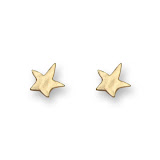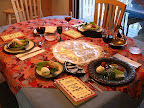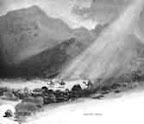Newsletter #9 - 4 April 2012
We offer you the coupon "spring-time" for 10% discount at Bluenoemi site Passover One of the Three Pilgrim Festivals, Celebrates the Exodus, the freedom from slavery of the Children of Israel from ancient Egypt that followed the Ten PlaguesCelebrations of Passover
In Jewish practice, one or two festive Seder meals - first two nights; in the times of the Temple in Jerusalem, the Korban Pesach
Passover is a Jewish and Samaritan holy day and festival commemorating the Hebrews' escape from enslavement in Egypt.
Passover begins on the 15th day of the month of Nisan (equivalent to March and April in Gregorian calendar), the first month of the Hebrew calendar's festival year according to the Hebrew Bible.
In the narrative of the Exodus, the Bible tells that G-D inflicted ten plagues upon the Egyptians before Pharaoh would release his Hebrew slaves, with the tenth plague being the killing of all of the firstborn, from the Pharaoh's son to the firstborn of the dungeon captive, to the firstborn of cattle.
The Hebrews were instructed to mark the doorposts of their homes with the blood of a spring lamb and, upon seeing this, the spirit of the Lord passed over these homes, hence the term "passover".
When Pharaoh freed the Hebrews, it is said that they left in such a hurry that they could not wait for bread to rise. In commemoration, for the duration of Passover, no leavened bread is eaten, for which reason it is called "The Festival of the Unleavened Bread".
MatzaMatza - (unleavened bread) is the primary symbol of the holiday. This bread that is flat and unrisen is called matzo.
Together with Shavuot ("Pentecost") and Sukkot ("Tabernacles"), Passover is one of the three pilgrimage festivals during which the entire Jewish populace historically made a pilgrimage to the Temple in Jerusalem. Samaritans still make this pilgrimage to Mount Gerizim, but only men participate in public worship.
Passover begins on the 15th day of the month of Nisan, which corresponds to the full moon of Nisan, the first month of the Hebrew calendar, in accordance with the Hebrew Bible.

SpringPassover is a spring festival, so the 14th day of Nisan begins on the night of a full moon after the vernal equinox. To ensure that Passover did not start before spring, the tradition in ancient Israel held that the first day of Nisan would not start until the barley is ripe, being the test for the onset of spring.
In Israel, Passover is the seven-day holiday of the Feast of Unleavened Bread, with the first and last days observed as legal holidays and as holy days involving abstention from work, special prayer services, and holiday meals; the intervening days are known as Chol HaMoed ("festival days").
Origins of the festival - The Exodus Passover is a biblically mandated holiday, indicating that it was already old and traditional by the time of the redaction of the Pentateuch.
In the first month, on the fourteenth day of the month between the two evenings is the LORD'S Passover. And on the fifteenth day of the same month is the feast of unleavened bread unto the LORD; seven days ye shall eat unleavened bread. In the first day ye shall have a holy convocation; ye shall do no manner of servile work. And ye shall bring an offering made by fire unto the LORD seven days; in the seventh day is a holy convocation; ye shall do no manner of servile work. (Leviticus 23:5)
The biblical regulations for the observance of the festival require that all leavening be disposed of before the beginning of the 15th of Nisan.
The Biblical commandments concerning the Passover (and the Feast of Unleavened Bread) stress the importance of remembering:
And thou shalt remember that thou wast a bondman in Egypt; and thou shalt observe and do these statutes." (Deuteronomy 16:12)
Exodus 12:14 commands, in reference to God's sparing of the firstborn from the Tenth Plague.
And this day shall be unto you for a memorial, and ye shall keep it a feast to the LORD; throughout your generations ye shall keep it a feast by an ordinance for ever.
Exodus 13:3 repeats the command to remember:
Remember this day, in which you came out of Egypt, out of the house of bondage, for by strength the hand of the LORD brought you
Origin of the name
The verb "passach" is first mentioned in the Torah account of the Exodus from Egypt (Exodus 12:23), and there is some debate about its exact meaning: the commonly held assumption that it means "He passed over", in reference to God "passing over" the houses of the Hebrews during the final of the Ten Plagues of Egypt, stems from the translation provided in the Septuagint in Exodus 12:23, and in Exodus 12:27).
Judging from other instances of the verb, and instances of parallelism, a more faithful translation may be "he hovered over, guarding." Indeed, this is the image used by Isaiah by his use of this verb in Isaiah. 31:5: "As birds hovering, so will the Lord of hosts protect Jerusalem; He will deliver it as He protecteth it, He will rescue it as He passeth over"
The term Pesach may also refer to the lamb or kid which was designated as the Passover sacrifice (called the Korban Pesach in Hebrew). Four days before the Exodus, the Hebrews were commanded to set aside a lamb.(Exodus 12:3) and inspect it daily for blemishes. During the day on the 14th of Nisan, they were to slaughter the animal and use its blood to mark their lintels and door posts. Up until midnight on the 15th of Nisan, they were to consume the lamb. Each family (or group of families) gathered together to eat a meal that included the meat of the Korban Pesach while the Tenth Plague ravaged Egypt.
In subsequent years, during the existence of the Tabernacle and later the Temple in Jerusalem, the Korban Pesach was eaten during the Passover Seder on the 15th of Nisan. However, following the destruction of the Temple, no sacrifices may be offered or eaten. The Seder Korban Pesach, a set of scriptural and Rabbinic passages dealing with the Passover sacrifice, is customarily recited during or after the Mincha (afternoon prayer) service on the 14th on Nisan. The story of the Korban Pesach is also retold at the Passover Seder,meaning order, and the symbolic food which represents it on the Seder Plate is usually a roasted lamb shankbone, chicken wing, or chicken neck.
Historically, these terms have been used interchangeably: "Now the Feast of Unleavened Bread, which is called the Passover, was approaching." (Luke 22:1)
However, at least from the first century, it was commonly held among Pharisees, that the Feast of Unleavened Bread started the day following the Passover feast, and lasted seven days:
"The feast of unleavened bread succeeds that of the passover, and falls on the fifteenth day of the month, and continues seven days, wherein they feed on unleavened bread; But on the second day of unleavened bread, which is the sixteenth day of the month, they first "partake of the fruits of the earth, for before that day they do not touch them, (Antiquities of the Jews Book 3, Chapter 10, Section 5)."
Chametz Chametz refers either to a grain product that is already fermented (e.g. yeast breads, certain types of cake, and most alcoholic beverages), or to a substance that can cause fermentation (e.g. yeast, sourdough or high fructose corn syrup). The consumption of chametz is forbidden during Passover in most Jewish traditions. According to Halakha, the ownership of chametz is also proscribed.
The specific definition of chametz varies among religious and ethno-cultural traditions. In Ashkenazic and certain Sephardic applications of Jewish Law, chametz does not include baking soda, baking powder or like products. Although these are leavening agents, they leaven by chemical reaction whereas the prohibition against chametz is understood to apply only to fermentation. Thus, bagels, waffles and pancakes made with baking soda and matzo meal are considered permissible, while bagels made with yeast, sourdough pancakes and waffles, and the like, are prohibited. Karaite Jews and many non-Ashkenazic Jewish traditions do not observe a distinction between chemical leavening and leavening by fermentation.
Observant Jews typically spend the weeks before Passover in a flurry of thorough housecleaning, to remove every morsel of chametz from every part of the home. Jewish law requires the elimination of olive-sized or larger quantities of leavening from one's possession, but most housekeeping goes beyond this. Even the cracks of kitchen counters are thoroughly scrubbed, for example, to remove any traces of flour and yeast, however small. Any item or implement that has handled chametz is generally put away and not used during Passover. Due to the Torah injunction not to eat chametz during Passover, observant families typically own complete sets of serving dishes, glassware and silverware which have never come into contact with chametz, for use only during Passover. Under certain circumstances, some chametz utensils can be immersed in boiling water (hagalat keilim) to purge them of any traces of chametz that may have accumulated during the year. Many Sephardic families thoroughly wash their year-round glassware and then use it for Passover, as the Sephardic position is that glass does not absorb enough traces of food to present a problem. Similarly, ovens may be used for Passover either by setting the self-cleaning function to the highest degree for a certain period of time, or by applying a blow torch to the interior until the oven glows red hot (a process called libun gamur).
The main symbol of the Passover holiday is matzo, or unleavened bread. This is a type of flatbread made solely from flour and water which is continually worked from mixing through baking, so that it is not allowed to rise. Matzo may be made by machine or by hand; the latter type of matzo, called shmura matzo ("watched" or "guarded" matzo), is the bread of preference for the Passover Seder in Orthodox Jewish communities.
The Torah contains a Divine commandment to eat matzo on the first night of Passover and to eat only unleavened bread (i.e., matzo) during the entire week of Passover. Accordingly, the eating of matzo figures prominently in the Passover Seder. There are several explanations for this.

The Torah says that it is because the Hebrews left Egypt with such haste that there was no time to allow baked bread to rise; thus, flat bread, matzo, is a reminder of the rapid departure of the Exodus. Other scholars teach that in the time of the Exodus, matzo was commonly baked for the purpose of traveling because it preserved well and was light to carry (making it similar to hardtack), suggesting that matzo was baked intentionally for the long journey ahead.
Matzo has also been called Lechem Oni (Hebrew: "poor man's bread"). There is an attendant explanation that matzo serves as a symbol to remind Jews what it is like to be a poor slave and to promote humility, appreciate freedom, and avoid the inflated ego symbolized by leavened bread.
It is traditional for Jewish families to gather on the first night of Passover (first two nights in communities outside the land of Israel) for a special dinner called a seder (ס×"ר--derived from the Hebrew word for "order", referring to the very specific order of the ritual). The table is set with the finest china and silverware to reflect the importance of the meal. During this meal, the story of the Exodus from Egypt is retold using a special text called the Haggadah. Four cups of wine are consumed at various stages in the narrative.
The seder is replete with questions, answers, and unusual practices (e.g. the recital of Kiddush which is not immediately followed by the blessing over bread, which is the traditional procedure for all other holiday meals) to arouse the interest and curiosity of the children at the table. The children are also rewarded with nuts and candies when they ask questions and participate in the discussion of the Exodus and its aftermath. Likewise, they are encouraged to search for the afikoman, the piece of matzo which is the last thing eaten at the seder. Audience participation and interaction is the rule, and many families' seders last long into the night with animated discussions and much singing. The seder concludes with additional songs of praise and faith printed in the Haggadah, including Chad Gadya ("One Kid Goat").
MarorMaror, one disallowed type and two acceptable kinds (L to R): "chrein" (Yiddish)- grated horseradish with cooked beets and sugar, not acceptable maror due to its sweetness; romaine lettuce; and whole horseradish root, often served grated.
A commandment to eat Maror, bitter herbs (typically, horseradish, romaine lettuce, or green onions), together with matzo and the Passover sacrifice Exodus 12:8. In the absence of the Temple, Jews cannot bring the Passover sacrifice. This commandment is fulfilled today by the eating of Maror both by itself and together with matzo in a Koreich-sandwich during the Passover seder.
Recounting the Exodus
On the first night of Passover (first two nights in communities outside Israel), a Jew is required to recount the story of the Exodus from Egypt. This commandment is performed during the Passover seder.
Four cups of wine
There is a Rabbinic requirement that four cups of wine are to be drunk during the seder. This applies to both men and women. The Mishnah says (Pes. 10:1) that even the poorest man in Israel has an obligation to drink. Each cup is connected to a different part of the seder: the first cup is for Kiddush, the second cup is connected with the recounting of the Exodus, the drinking of the third cup concludes Birkat Hamazon and the fourth cup is associated with Hallel.
Children in Passover
The four questions
Children have a very important role in the Passover seder. Traditionally the youngest child is prompted to ask questions about the Passover seder, beginning with the words, Mah Nishtana HaLeila HaZeh (Why is this night different from all other nights?). The questions encourage the gathering to discuss the significance of the symbols in the meal. The questions asked by the child are:
Why is this night different from all other nights?
On all other nights, we eat either unleavened or leavened bread, but tonight we eat only unleavened bread?
On all other nights, we eat all kinds of vegetables, but tonight, we eat only bitter herbs?
On all other nights, we do not dip [our food] even once, but tonight we dip twice?
On all other nights, we eat either sitting or reclining, but tonight we only recline?
Often the leader of the seder and the other adults at the meal will use prompted responses from the Haggadah, which states, "The more one talks about the Exodus from Egypt, the more praiseworthy he is." Many readings, prayers, and stories are used to recount the story of the Exodus. Many households add their own commentary and interpretation and often the story of the Jews is related to the theme of liberation and its implications worldwide.
Afikoman
The afikoman -- an integral part of the Seder itself -- is used to engage the interest and excitement of the children at the table. During the fourth part of the Seder, called Yachatz, the leader breaks the middle piece of matzah into two. He sets aside the larger portion as the afikoman. Many families use the afikoman as a device for keeping the children awake and alert throughout the Seder proceedings by hiding the afikoman and offering a prize for its return. Alternately, the children are allowed to "steal" the afikoman and demand a reward for its return. In either case, the afikoman must be consumed during the twelfth part of the Seder, Tzafun.Concluding songs After the Hallel, the fourth glass of wine is drunk, and participants recite a prayer that ends in "Next year in Jerusalem!". This is followed by several lyric prayers that expound upon God's mercy and kindness, and give thanks for the survival of the Jewish people through a history of exile and hardship. Some of these songs, such as "Chad Gadiyah" are allegorical.

Common Foods Because the house is free of chametz for eight days, the Jewish household typically eats different foods during the week of Passover. Many meals include leftovers from the initial seders. Other foods are also prepared, these include:
1. Matzah brei - Softened matzah fried with egg and fat; served either savory or sweet
2. Matzah Cereal - A fine matzah meal, boiled in water and often served with milk and butter
3. "Matzah Kugel" - Kugel made with matzah instead of noodles.
4. "Charoset" - a sweet, dark-colored, lumpy paste made of fruits and nuts
5. "Chrain" - horseradish and beet relish
6. "Gefilte fish" - poached fish patties or fish balls made from a mixture of ground deboned fish, mostly carp or pike
7. "Chicken Soup with Matzah balls" - Dumpling made from matzah meal served in soup
8. "Rice, often with saffron or raisins - nearly all Sephardic Jews and many Mizrachi and Ashkenazi Jews consider rice to be an essential food for the Passover table. There is much controversy, however it is to be noted from the Talmud (Pesahim 114b,) "What are the two cooked foods served at the Seder table? Rab Huna said, 'spinach and rice.'" Thus, the accepted tradition, as confirmed in the commentary of Rashi is that rice is not Chametz. The concern arises from worries that in storage, rice may have been contaminated with even one kernel of wheat or other chametz. Therefore, rice must be carefully inspected prior to cooking. Some Haredi sects do not eat rice as a matter of minhag.

Matzo BreiIngredients
* 1 matzo cracker
* 1 egg
* salt and pepper to taste
* 2 tablespoons vegetable oil
Cooking Instructions
1. Take the matzo and break into small pieces into a bowl. Cover with hot water for a minute. Then squeeze out the water.
2. In a small bowl, beat one egg with salt and pepper to taste and add to matzo. Mix well.
3. Heat frying pan with a little oil. Pour mixture into the pan. Brown one side and turn over.
Matzo balls soup Ingredients
* 2 (10 ounce) packages matzo crackers
* 1/2 cup butter
* 6 eggs
* salt and pepper to taste
* 3 tablespoons minced fresh parsley
* 2 onions, minced
* 5 ounces matzo meal
* 96 ounces chicken broth
Cooking Instructions
1. Bring a large pot of lightly salted water to a boil.
2. Break matzo crackers into small pieces, and place in a large bowl. Add water to cover; allow to soak for a few minutes, until soft. Drain off excess water.
3. Melt butter in a large skillet over medium heat and stir in drained matzos; stir until mixture is dry and slightly brown. Remove from heat, and mix in eggs, salt and pepper to taste, parsley, and onions.
4. Mix in just enough matzo meal to make mixture hold together. Roll one golf ball-size matzo ball. Place matzo ball in the boiling water to test the mixture. The ball must rise to the top of the water and not break apart. If it does not rise, then too much matzo meal was added. In this case, add another beaten egg to the mixture and try again. When desired consistency is reached, roll all of mixture into golf ball size spheres.
5. In a large saucepan, bring chicken broth to a slow boil over medium heat; add balls to broth. Serve soup as the balls rise to the top of the broth.
MA NISHTANA
(WHY IS THIS NIGHT DIFFERENT FROM ALL OTHER NIGHTS?)
Ma Nishtana, halaila hazeh, mikol ha'leilot? mikol ha'leilot?
(1) She bechol ha'leilot, anu ochlim - CHAMETZ U'MATSAH; CHAMETZ U'MATSAH
Ha'laila hazeh, ha'laila hazeh - KOO'LOH MATSAH, KOO'LOH MATSAH.
(2) She bechol ha'leilot, anu ochlim - SHE'AR YERAKOT; SHE'AR YERAKOT
Ha'lailah hazeh, ha'lailah hazeh - KOO'LOH MA'ROR; KOO'LOH MA'ROR.
(3) She bechol ha'leilot, ein anu matbilim - AFILU PA'AM ECHAT; AFILU PA'AM ECHAT
Ha'laila hazeh, ha'laila hazeh - SHE'TEI PE'A'MIM; SHE'TEI PE'A'MIM.
(4) She bechol ha'leilot, anu ochlim - BEIN YOSHVIN U VEIN MESUBIN, BEIN YOSHVIN U VEIN MESUBIN
Ha'laila hazeh, ha'laila hazeh - KOOLANU MESUBIN, KOOLANU MESUBIN.
AVADIM HAYINU (WE WERE SLAVES, NOW WE ARE FREE)
Avadim hayinu, ha-yi-nu. Atah b'nei chorin, b'nei chorin.
Avadim, ha-a-yinu, Atah, Atah, b'nei chorin.
Avadim, ha-a-yinu, Atah, Atah, b'nei chorin, b'nei chorin.
V'HEE SHE'AMDAH (AS GOD HAS STOOD WITH US)
Ve'hee she'amdah, ve'hee she'amdah, la-avoteinu vela-nu (x2)
Shelo - echad - bil'vad, a'mad aleinu le'chaloteinu (x2)
Ela, she bechol dor va dor, omdim aleinu le'chaloteinu (x2)
Vehakadosh barooch hoo, matzileinu mi-yadam (x2)
DAYEINU
(IT WOULD HAVE BEEN ENOUGH!!)
Ilu hotsi - hotsiyanu, mimitzrayim hotsiyanu - velo asah bahem shvatim - Dayenu.
Chorus:
Dai-dai-yenu (x3) Dai-yenu, dai-yenu, dayeinu! Dai-dai-yenu (x3) Dai-yenu, dai-yenu!
HALLELUYAHHalleluyah, Halleluyah, betsil'tselay shama.
Halleluyah, Halleluyah, betsil'tselay tru'ah.
Kol han'shamah, tehalel'yah; Halleluyah, Halleluyah.
ELIYAHU HANAVI
(ELIJAH THE PROPHET)
Eliyahu ha-na-vi. Eliyahu ha'tish'bi. Eliyahu ha-giladi.
Bim'heira-ah yavoh eleinu, im mashi-i-i-ach ben-david. (x2)
ADIR HU
(HE IS GREAT)
Adir hoo, adir hoo, yivneh veito beka'rov.
Bim'heirah-ah, bim'heirah, be'yameinu beh'ka-a-roh-ov,
Eh-el b'nei, eh-el b'nei, bnei veit'cha beh'kah'ah-rov.
ECHAD - MI YODEIYA
(WHO KNOWS ONE?)
Leader: Echad, Mi Yodeiya? All: Eh-eh-chad, Ani yodeiya.
Eh-eh-chad ( ELOHEINU x 5)
SHEH BA'SHAMA'YIM, OO'VA'AH'AH'RETZ.
(Repeated at the end of each of the 13 verses!!)
2. Shna'yim, ani yodeiya. Shnei lu'chot habrit. ( EH-EH CHAD ELOHEINU x 5)
3. Shlo'sha, ani yodeiya. Shlo'osha ah-ah-vot. (Shnei lu'chot habrit. Echad....)
4. Ar'ba-ah, ani yodeiya. Arba'ah ima'ot. (Shlosha ah'a'vot. Shnei.lu'chot.habrit...)
5. Chamisha, ani yodeiya. Chamisha choom'shei torah. (Ar'ba-ah ima'ot. Shlo'sha...)
6. Shi'i'sha, ani yodeiya. Shi'isha sidrei mishnah. (Chamisha choom'shei torah....)
7. Shi'i'v-ah, ani yodeiya. Shi'i'vah yamei shivtah. (Shi'isha'sidrei mishnah.......)
8. Shmoh-oh-na, ani yodeiya. Shmo'o'nah yamei milah. (Shi'i'vah yamei shivtah....)
9. Ti'i'shah, ani yodeiya. Ti'i'sha yar'chei leidah. (Shmo'o'nah yamei milah...)
10. Asarah, ani yodeiya. Asarah'ah dib'ra'ya. (Ti'i'sha yar'chei leidah.....)
11. Achad-asar, ani yodeiya. Achad-asar koch-va-ya. (Asarah'ah dib'ra'ya........)
12. Shneim-asar, ani yodeiya. Shneim-asah-ar shiv-ta-ya. (Achad-asar koch-va-ya...)
13. Shlosh-asar, ani yodeiya. Shlosh-asah-ar mi-da-ya. (Shneim-asah-ar shiv-taya...)
CHAG SAMEACH!
Bluenoemi - Tel Aviv
admin@bluenoemi-jewelry.com
|
|
|













